- Hawaii
- Where to Snorkel in Hawaii: Our Favorite Spots

Hawaii has an abundance of snorkeling spots throughout the islands. Thanks to its coral reefs and protected areas, snorkeling is a must in Hawaii, as the seabed is rich and full of fish.
In this article, we will review the 4 main islands of Hawaii (Kauai, Big Island, Maui and Oahu) and list the beaches and areas most suitable for observing underwater life. We will end this article with some tips on how to get the most out of snorkeling in Hawaii.
Please note that the ratings of the spots below have been re-evaluated compared to those indicated in the respective articles, in order to compare all the snorkeling sites between them, whatever the islands (the ratings in the articles also take into account the setting, the beach and the frequentation...)
Summary
1The best snorkeling spots in Kauai
Tunnels Beach
Let's start with the most famous snorkeling spot on Kauai and considered the best! Located in the extension of Kepuhi beach, Tunnels Beach is famous for its semi-circular reef which is beautiful from the sky.

This reef has the advantage of forming a natural protection zone for the fish, which are thus numerous to frequent the area. Finally, the sandy zone is only found on the first few meters, so the water is usually clear and the fish are easily visible.
We have enjoyed every snorkeling experience here. And if the sand gets in the way of the water, just move away from the shore.
Another particularity, the rocks are numerous underwater and covered with seaweed which makes it a place of predilection to come to swim with the turtles which come to eat the seaweed here.

However, do not expect to find beautiful sea bottoms here, as the corals are not very present (at least from what we noticed, but we did not explore the whole reef). The beach being long, you will have many possibilities to get into the water.
For more safety, we advise you to enter the middle of the area and to advance towards the end of the reef without approaching it too closely. Above all, do not try to reach the reef and avoid the eastern and western extremities of the small passes where the currents are the strongest and could carry you away.
Anini Beach
Anini Beach is a long and beautiful beach in the north of Kauai. It has the advantage of having a reef that protects it from the waves and makes it an excellent snorkeling spot where turtles are present.
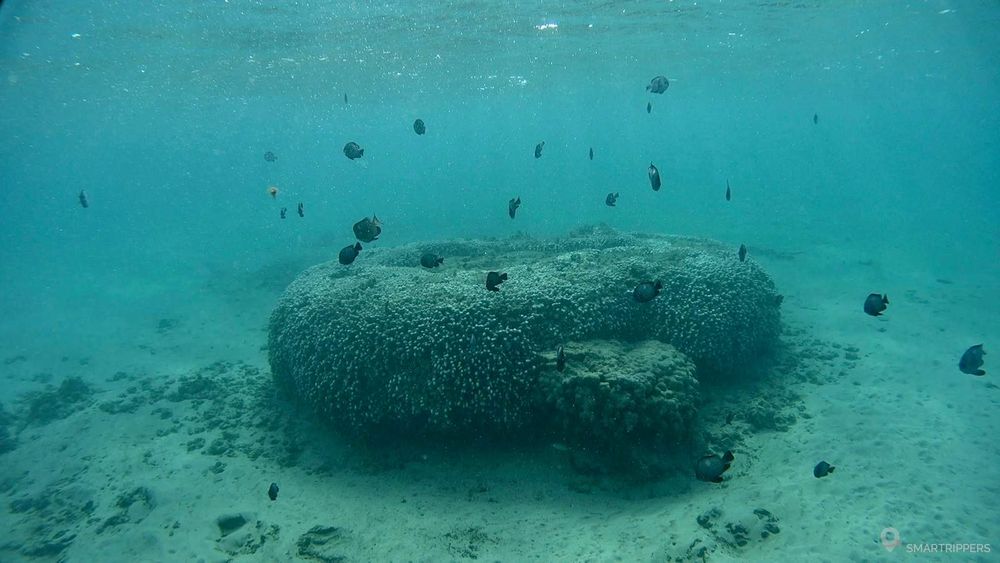 A coral colony and its myriads of small fish. It is superb!
A coral colony and its myriads of small fish. It is superb!We like to come to Anini Beach because it is one of the places in Kauai (along with Poipu Beach) where you can swim all year round without being too worried by the waves. The disadvantage of Anini Beach is that you sometimes have to go far from the shore to see the first coral colonies (especially if you come at the main parking lot), unless you go in the water where the reef is closer to the beach.
Beware also of the currents which can be important even if the surface of the water looks calm.
The shallows are far away, and the desire to explore the area is great, especially when you have your head down and you are looking for the most colorful fish, the most colorful corals... But the moment arrives when you have to come back to the beach, and you need strength for that.
As for the fish, we found that they were less numerous than at the other snorkeling spots in Kauai, but we saw some species here that we did not find elsewhere. Finally, beautiful corals cover the seabed and are sometimes scattered on the clear sand, which makes the snorkeling very interesting.
Ke'e Beach
Ke'e Beach is located at the very end of the Kuhio Highway within the Ha'ena State Park. A reef borders the beach with a section that comes close to the beach.

This barrier makes it a pleasant place to swim when the ocean is calm and makes the area particularly suitable for snorkeling and especially for turtle watching. Finally, since the implementation of the access limitation, there are many less people, which is not to displease!
The swimming is lifeguarded but be careful because of the currents. Don't hesitate to walk a little to the right to find a quiet spot in the shade of the trees.

To get to Ke'e Beach, you will need to make a reservation beforehand to get access to the parking lot, which is shared with the Kalalau Trail. As the parking spaces are very popular, we recommend that you make your reservation as soon as the spaces are available for sale, i.e. one month before. Learn more about the reservation system.
Poi'pu Beach
This is the most touristic and popular snorkeling spot on Kauai, but also the most accessible. Here, beginners will find a lot of opportunities to practice this new activity, in shallow water, and may have the chance to swim with a turtle, like us. The fish are numerous and not very shy, but the shallow water may discourage the experienced snorkeler.

However, don't expect to have corals here. The ground is composed of rough rocks and is not very beautiful. We will go rather to Poi'pu for a first contact with the ocean.
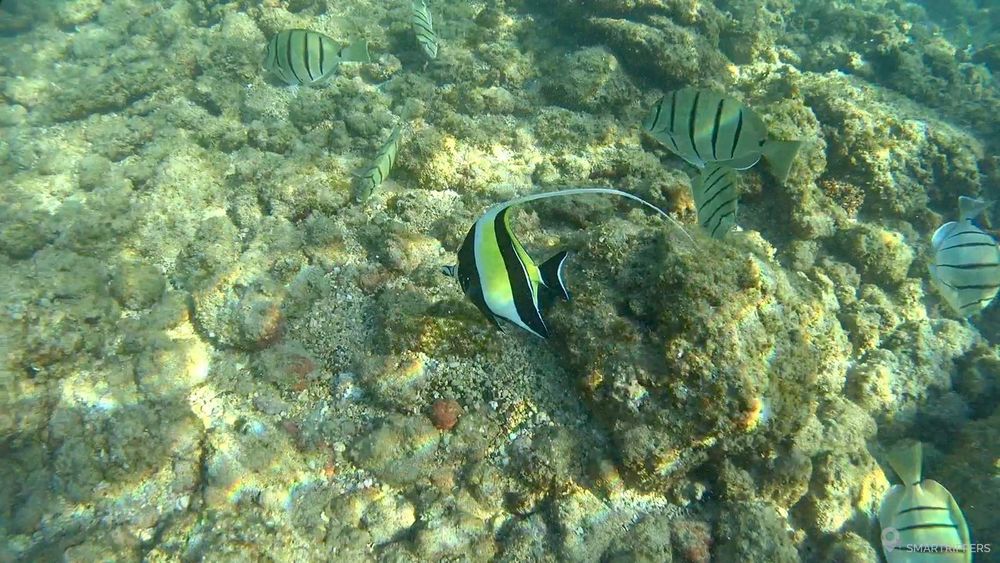
The beach is lifeguarded, however, be careful because the area on the right, at the rocks, can be dangerous with a strong side current. It is better to stay in the area near the lifeguard cabin.
Hideaways Beach
This beach lives up to its name. Hidden below the resorts of Princeville, this beach is difficult to access and offers an interesting snorkeling spot when the ocean is calm, as the beach is not really protected by a reef.
We will appreciate here the particularly clear water and fishes easily visible near the beach. On the side of the sea bed we will find some small corals but it is not crazy. The place being difficult of access, there will not be many people either on the sand or in the water.
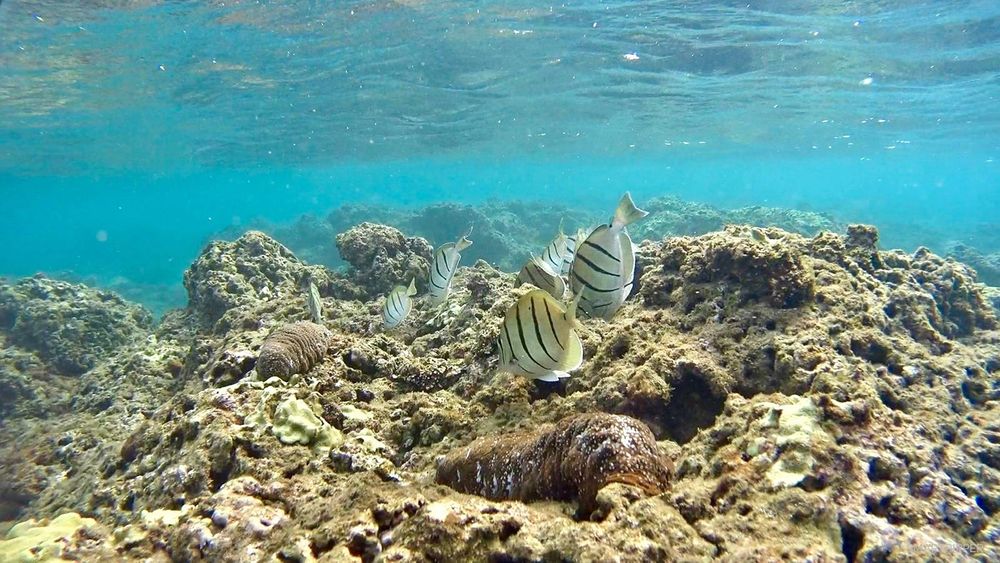
To get to the beach, you will have to park in a very small parking lot with only 8 spaces. Then you will have to take a path that descends quite steeply to the beach and help you with ropes.
Make sure you have the right shoes to go down to the beach because the access is very steep and you will have to hold on tightly to the rope that acts as a guardrail. Beware of slipping.
Lawa'i Beach
Located near Poi'pu Beach, Lawai'i Beach is best suited for experienced snorkelers because of the lack of reef protection and the presence of currents.
If the ocean is rough (very often during the winter), the waves can be numerous and the water cloudy. But when the conditions are right, it is possible to see many fish here. On the other hand, the sea floor is not very beautiful. Corals are rare and we noticed some breeze blocks in the water...

This spot is not very well protected from the waves, so it is best to go when the conditions are calm, otherwise you will be constantly tossed around.
2The best snorkeling spots in Oahu
Kahe Point Beach Park
This Beach Park doesn't look like much at first glance, especially with the imposing installations of the power plant next to the beach. Yes, it is very ugly! But it is the power plant that transformed this place into an aquarium, which makes it the best snorkeling spot on Oahu in our opinion.
The hot water discharges from the power station which flow near the beach attract many fishes here. Further out, we can find many carcasses of big metallic objects where corals and fishes have settled, like underwater wrecks. This spot is thus visited daily by tour operators who come to take their clients for scuba diving.
This spot is also frequented by dolphins and turtles. But like all the famous spots on Oahu, it is very crowded.
In case of heavy seas, it could be dangerous to come and swim here, as the currents carry you out to sea and the waves are dangerous. Do not leave any valuable effects in your car, as break-ins are not uncommon here.
Three Tables Beach
This small beach in Pūpūkea in northeast Oahu is not very famous, yet it offers good snorkeling conditions thanks to its protection by the Pūpūkea Marine Life Conservation District. Moreover, turtles are frequently seen there.

The area is not very rich in corals but it is easy to see many species of fish here and the area to explore is quite large.
To take advantage of it, you will have to come here rather in summer, when the ocean is calm, as the waves usually prevent swimming in winter or in bad weather.
Hanauma Bay State Park
Hanauma Bay is a beautiful but very touristy nature reserve located at about 15 kilometers from Honolulu. This ancient crater, partly open to the sea, offers an interesting reef to discover while snorkeling. The place is classified as "Natural Reserve", which explains the abundance of marine life.
Here snorkeling is easy and accessible to all, the bay being protected by the reef which avoids the formation of waves, and it is not rare to see turtles.

Unfortunately the bay is a victim of its beauty and its proximity to Honolulu. The corals have been largely damaged in spite of the awareness video that it is mandatory to watch before entering the site. There is almost nothing left of the beautiful seabed of the past and the numerous tourists stir up the sand that clouds the water. The observation conditions are not optimal. The only positive thing is that it is easy to see many fish.
But fortunately, COVID-19 is not all bad. The many weeks of closure in 2020 brought the reef back to life! Since 2021, access is now limited to 720 people per day (112 people per hour)... hoping that this limitation will be maintained as long as possible to avoid that this beautiful reserve does not suffer again the ravages caused by over-frequentation.
Access to the beach is not free. It will cost $12 (from 12 years old) to go down on the sand and enjoy snorkeling. The parking is also paid at $3 a day.
We recommend that you check the Hanauma Bay website for all practical information (schedules, limitations, rates) as changes are frequent. Come as early as possible to hope to be able to park.
Shark's Cove
Shark's Cove, named after the nearby bay, is a shallow natural pool enclosed by small rocks. The natural pool is large and the water color is beautiful and clear. Unfortunately, as in Hanauma Bay, the place is a victim of its own success.

As a result, what could be an interesting snorkeling spot is transformed into a kind of giant paddling pool where fishes are not so numerous in front of the great number of snorkelers present in the pool. Also, the seabed is almost non-existent.
Nevertheless, if you are only staying on Oahu, or if you are traveling with young children, the experience can be interesting because the place is very easy to access. It is still a good opportunity to go and see some of the small and shy fish.
If you want to try the experience, remember to wear sea shoes. The rocks are numerous and can be sharp. Fins are not really necessary because the area is quite small and shallow. In case of rough sea, the experience will be less pleasant, as the waves pass over the rocky barrier.
For good swimmers, it should be noted that the real Shark's Cove Bay is located north of the pools, where the deeper water forms a small bay. This area is rich in fish thanks to the protection of the Pūpūkea Marine Life Conservation District and will potentially offer better quality snorkeling, but beware as the bay is often very rough if not dangerous.
3The best snorkeling spots in Maui
Āhihi Bay
The small bay of Āhihi is the ideal place to come and snorkel in shallow waters. Here the beach is not the most charming but we will come there to indulge in the joys of snorkeling, especially since the area is really rich in small colorful fish.

The bay forms an arc and offers many possibilities for snorkeling in calm sea. The area in the center near the shore is shallow, the rocks on the sides offer a nice coral diversity, and in the middle of the bay the water depth offers very interesting snorkeling in clear water due to the absence of sand.

The area being protected, we will make sure not to apply any harmful products on the skin before entering the water. Use only sunscreens that are non-toxic to corals (a notice and rangers will explain this to you at the parking lot which is common with the next spot: Āhihi Cove).
Āhihi Cove
This is the second snorkeling spot in the Āhihi Kīna'u Natural Area Reserve. It is located along a black pebble beach where you will discover underwater fauna that is very abundant and unafraid thanks to the protection zone. The absence of sand allows a good vision underwater.
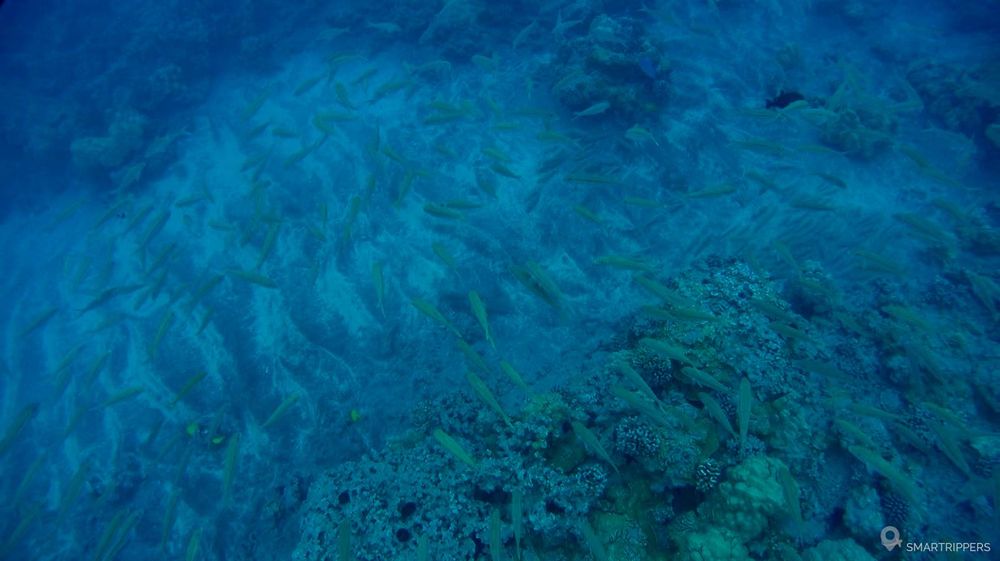
Here the seabed is deep, but some big rocks near the shore allow to observe beautiful specimens of fish and corals. The seabed is rich and colorful and very pleasant to observe. It is not uncommon to see turtles and fish species that you will not have seen elsewhere.
Volunteer rangers will probably be on hand to warn you to follow a few rules before venturing into the water and can also give you tips on what fish to look out for.
We recommend you to come here in the morning when the ocean is calm, and not to hesitate to approach the rocks to find the most beautiful fish specimens.
5 Graves
This is one of the best spots in Maui to swim quietly with turtles! Don't look for a nice beach here, there are only a few pebbles and rather sharp rocks, but the place is an excellent snorkeling spot to approach turtles. But be careful, it is for experienced snorkelers.

The advantage of this place is that the water is usually clear. The absence of sand offers a good visibility and the seaweeds are very present near the rocks, which attracts many turtles that come to feed. On the other hand, there are not many fish here.

The place also has the advantage of being little known and very little frequented. It is therefore a very pleasant place!
However, vigilance will be required here because the currents can be very strong. Only go in the water if the ocean is calm and do not get too close to the rocks, as you might get knocked down by the waves.
Slaughterhouse Beach
This small, secluded, sandy beach with a beautiful water color offers great snorkeling conditions. This beach is located with Honolua Bay in the Honolua-Mokuleia Bay Marine Life Conservation District, a protected area that allows fish to remain untouched by fishing.
Fish and turtles are therefore very numerous here near the rocky areas at the ends of the beach.

The other side of the coin is that this beautiful beach is very popular and the parking possibilities are very limited near the beach, hence its reasonable attendance (which is not bad, if you find a parking space...).
It is therefore preferable to come early in the morning or in the evening and avoid weekends if possible. It is important to come in calm sea (and rather in summer), because the waves and currents can be strong here, which makes snorkeling dangerous.
Honolua Bay
We now arrive at the most famous snorkeling spot on Maui. The beautiful Honolua Bay is well known for its abundant underwater fauna thanks to its protected area by the Honolua-Mokuleia Bay Marine Life Conservation District. From the air, the bay is beautiful and looks promising.

However, our disillusion was total. Yes, the spot is great for swimming with turtles, we easily saw some. On the other hand, we were disappointed by the crowds here. The bay is full of swimmers (coming from the beach but also from the numerous tour boats).

As a result, the corals are completely ravaged at the edge of the bay and you have to go quite far to find beautiful coral colonies in good condition. Honolua Bay had everything to be a snorkeling paradise and unfortunately it became a tourist attraction.
If you like snorkeling, you may be disappointed by the overcrowding and the damaged corals, as in Hanauma Bay on Oahu. Nevertheless, the bottom is beautiful as soon as you go far enough into the bay and the marine fauna is relatively abundant. In short, a site to discover early in the morning, or at the end of the day, when the crowd and the boats have left the area.
Chang's Beach (Makena Snorkeling Bay)
This is where a little-known and easily accessible snorkeling spot in Southwest Maui is hidden. The very small Chang's Beach (also called Makena Snorkeling Bay) is located below a residential area. The beach is framed by many rocks which makes it an excellent place to see some fish and especially turtles.

We will appreciate to come here in the quietness to swim with the turtles although the sea bed is not particularly interesting near the beach. It is mostly large rocks covered with algae that attract turtles.
Molokini crater
Located a few kilometers southwest of the island of Maui, Molokini is an ancient crater with only a small "crescent" shaped tip protruding from the water. This site is a very famous snorkeling spot, known for its abundant and preserved marine life. However, with the arrival of tourism, many tour companies offer day or half-day trips. These excursions are expensive and bring more and more tourists to the small crater.
Nevertheless, the Molokini crater has the reputation of being one of the most beautiful snorkeling spots near Maui, but as we did not dare to try it, we cannot say more for the moment.
We also decided not to give a grade to this snorkeling site because the opinions are very divided. We had both very positive feedbacks from people who enjoyed the excursion and discovered beautiful sea beds, but also very negative ones, from people who were disappointed by the crowds and judged the sea beds similar to the famous spots of Big Island.
4The best snorkeling spots on Big Island
Kealakekua Bay (James Cook Monument)
This is certainly the best place on Big Island, if not the whole archipelago, for snorkeling! Kealakekua Bay is a protected area as a "Marine life conservation district". The marine fauna is incredibly diverse and the corals are numerous.
The best place to get into the water is on the edge of the famous bay where James Cook was killed in 1795. The access is precisely at the feet of the white stele erected in memory of the famous navigator. Here the waters are full of tropical fish only a few centimeters below the surface and they are not shy! It is a real aquarium!

The corals are still numerous, but for how long? Because the other side of the coin is the over-frequentation of the site by the excursion boats which came to deposit there all day long hundreds of snorkelers and of which certain large models contributed greatly to pollute the places...

Fortunately, things seem to be getting better as measures have since been taken to restrict access to the bay and it seems that large tour boats are no longer allowed...
There are three options for accessing Kealakekua Bay and enjoying snorkeling. Hiking, kayaking or boat tours. Learn more about access to Kealakekua Bay.
If you choose to come by foot, we ideally recommend that you get there before 10:00 a.m., when the tour boats are more numerous.
Swim with manta rays
This is not a snorkeling spot as such, but it is an experience not to be missed and that can only be done on Big Island, close to Kona.
There are 3 manta ray sites along the west coast of the island, the main site being near the airport. Every evening, boat trips are organized to observe the manta rays, either by snorkeling, hanging on a float board or diving with bottles.

The observation is just spectacular! The plankton, attracted by the blue light emitted by the device fixed to the board, comes to pile up under the board. At lunch time, the manta rays come close to us to swallow all the plankton. They pass a few centimeters away from our torso, making large parabolas.

We did this trip twice and each time we saw between 5 and 7 manta rays simultaneously! This experience is clearly a must on Big Island!
Pae'a or Two Steps
Pae'a, also called "Two Steps" because of the 2 steps used to enter and especially exit the water, is located in the heart of Hōnaunau Bay. It is an excellent snorkeling spot!
Here you will find only a large rocky platform, formed by an ancient lava flow. The bottom is moderately deep and the absence of sand makes the water clearer (except in case of warm currents that can disturb the water).

The main interest, apart from the myriad of small yellow fish, is that it is not necessary to go far from the shore to observe an abundant marine fauna. Many fishes are present near the rocks and turtles frequent the area.

The seabed is quite interesting although the corals are not in great shape. It is sometimes possible to observe dolphins in the bay (small signs near the road will give you explanations).
The main access is located at the level of the 2 steps at the end of the rocky area. Be careful because this access can be dangerous if the sea is rough, as the waves can knock you down on the rocks. An easier access is possible from the thin sandy beach or from the boat ramp, both located on the right side of the rocky area. However, you will have to swim a little to reach the fishy area located near the two steps.
Avoid swimming barefoot because of the sea urchins present on the rocks, choose instead flippers, shoes with hard soles, such as windsurfing ones, or even sea sandals.
Kahalu'u Beach Park
This is one of the most easily accessible and popular snorkeling spots on Big Island. The water is shallow near the shore, despite slippery flat rocks that can make the entry into the water sometimes tricky depending on the tide. Once the obstacle is overcome, you will find a nice sandy and rocky platform where fish are usually very numerous.
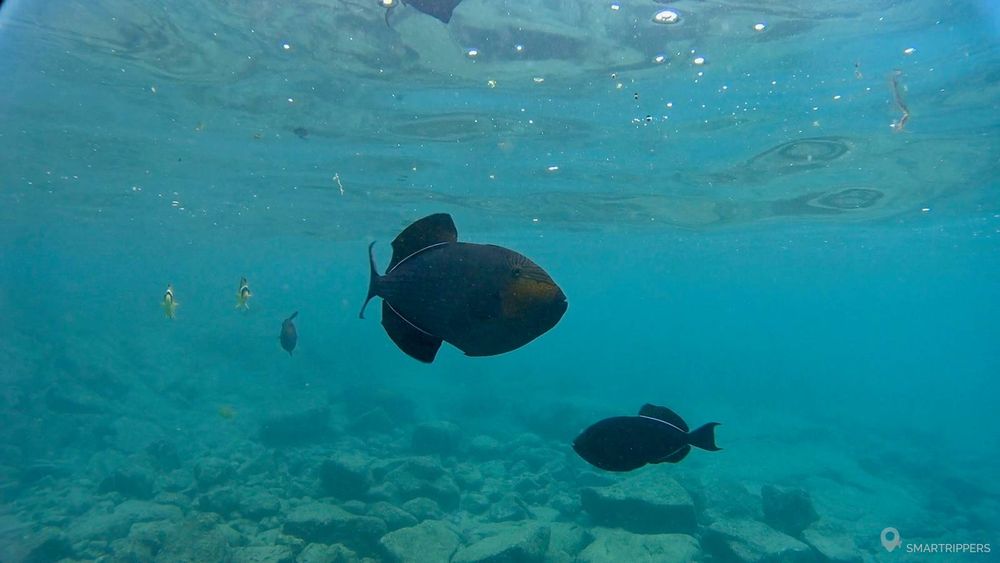
In 2017 we saw only few fish there while were much more present in 2019.
A beautiful seabed is almost non-existent near the shore, but good swimmers will be able to move to the middle of the bay or to the coral reef, to see beautiful corals at greater depths. The water will also be clearer there, as the area near the beach is sometimes cloudy because of the sand. Please note that the swimming is lifeguarded.
Carl Smith Beach Park
This beautiful Beach Park in Hilo is one of the best places on the Big Island to swim with the turtles that often come to visit the place which is rich in seaweed. Moreover the color of the water is superb!
The main swimming area is located on the right side of the park, behind the trees. It has the advantage of being protected from the waves thanks to ancient lava flows which form a small natural barrier. On the other hand, the seabed is quite poor here and the fishes are few, so we will come here especially for the turtles.

As the pools are very shallow, the place is recommended for families with young children, especially as access to the water is easy thanks to the stairs and ramps that have been installed.
On the other hand, you should expect that the water will sometimes be disturbed by shifting sand (wind or crowds), or because of the presence of cold springs that flow into the ocean and mix with the warm water.
We advise you to come to Carl Smith Beach Park on a weekday to relax, as the place is very popular with locals on weekends.
Mahukona Beach Park
This snorkeling spot has the advantage of being little frequented and the water is particularly clear thanks to the absence of sand. The area is also sheltered from the wind, offering good visibility and ideal conditions for underwater observation.
The entire coastal area is protected by the Lapakahi Marine Life Conservation District which allows the marine wildlife to remain unharmed.
However, not all of our experiments here have been promising, with the fish being more or less present on different days.

The seabed is quite classical with some corals. You should expect an average depth of 3 to 4 meters. The access to the water is easy thanks to a ladder. There is no beach here.
5Our tips for enjoying snorkeling in Hawaii
Is snorkeling in Hawaii dangerous?
Rest assured, despite the presence of some dangerous animals, snorkeling is not a dangerous activity in Hawaii. However, you must be careful of the currents.
Sharks
Sharks are present in large numbers in the archipelago, and there are generally about ten attacks each year (which are very rarely fatal - on average one or two every 10 years) and which mainly concern surfers.
However, let's not stigmatize because according to statistics, you only have a one in a million chance of being bitten by a shark in Hawaii. So bites are extremely rare.

In order to put all the chances on your side, some precautions should be taken, such as not swimming in areas where the danger is indicated. In these areas, a sign with a shark is usually well visible. It should also be noted that the vast majority of attacks occur in areas that are not necessarily suitable for snorkeling, as they are usually protected by a coral reef.

To learn more about sharks and shark attacks in Hawaii, you can visit this comprehensive website which also provides some behavioral tips to reduce the risk of attack.
Moray eels

Small moray eels are quite common in Hawaii. Keep your distance from them as they can be aggressive if you become a threat to them. They are often found lurking in cavities. So don't be tempted to poke them and take another route if you see one.
Sandrine had the bitter experience of passing near a moray eel swimming in 60 cm of water. It suddenly jumped on her at face level, but fortunately, without touching her.
In case of a bite, do not hesitate to go to a drugstore, they are used to it.
Currents
The main danger will come from the currents which can be strong and sometimes invisible. For this reason, look carefully at the signs on the spot before jumping into the water. The potential presence of currents is most often indicated by small signs.
Currents often occur in small "passes", holes in the coral reef. So avoid approaching these areas.
Equipment needed for snorkeling in Hawaii
We recommend that you always practice snorkeling with fins, especially because of the currents, especially if you don't have footholds. This will help you in case of need.
In safe areas and/or if you have foothold, we recommend either fins or shoes with a rigid sole (windsurfing type or rubber sandals). This will protect you from corals and rocks that can be sharp, as well as sea urchins (found on some spots). In any case, always avoid swimming barefoot.
Equipment rental
If you don't have room in your suitcase, you can rent your snorkeling equipment on site. Several stores offer snorkeling equipment for rent, but the prices are quite high, especially if you rent your equipment for several days or weeks.
It will often be more interesting to pay for an extra hold baggage for the plane than to rent your snorkeling equipment for several days, especially if you are two or more...
We are Sandrine and Flo, French thirty-somethings. In 2019 we quit everything to live our dream, become nomads and travel around the world. We left with our baby, Lena, who was only 5 months old at the time. After a first trip around the Pacific Ocean by plane and a long 3 months stay in Hawaii, we left to discover Iceland for 3 months on board our 4WD pickup truck and truck camper. Then we continued our adventure in North America.
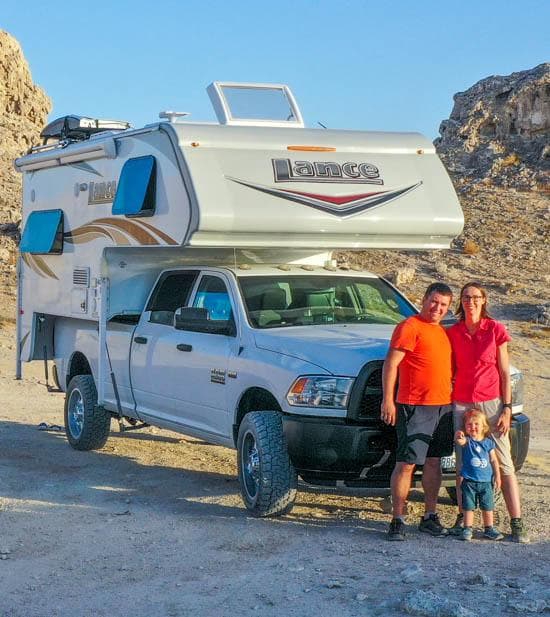
Today, if we can continue this adventure, it is above all thanks to our blog, Smartrippers! We created it one day in 2016, with the desire to share our good travel tips, without thinking that it would lead us there! We have developed it a lot over the years and have become experts on our 3 favorite destinations: Hawaii, Iceland and the American West. We now guide you to these destinations to help you plan the trip of your dreams!
Follow our adventures!